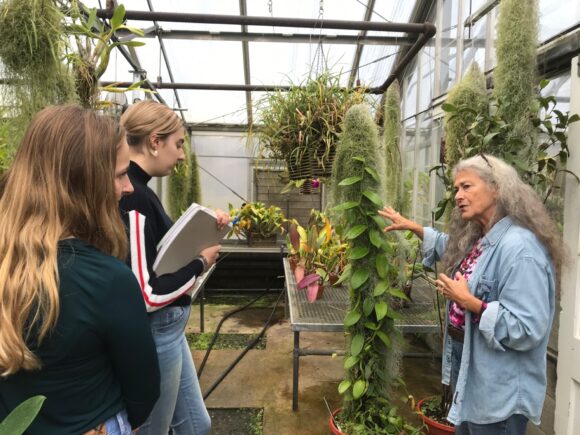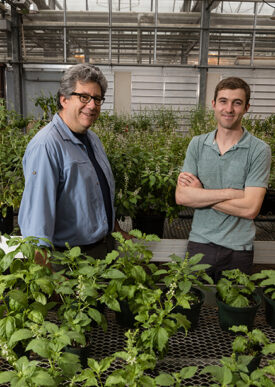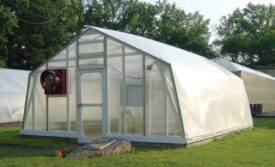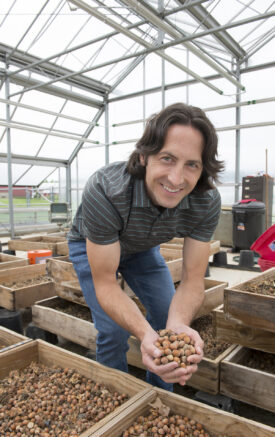
Nicki Graf, research farm supervisor at the Floriculture Greenhouse, instructs ag education students.
Whether covered in glass or polyethylene, the most diverse spaces on the George H. Cook campus are the greenhouses–with one making agricultural history and revolutionizing the industry.
The prominence of greenhouses on the George H. Cook campus reflects the orientation of the school toward the natural sciences. However, not transparent is the impressive number and configurations of structures, and the vast diversity of activities within. A stroll across campus reveals the main glasshouses that are hard to miss—the Research Greenhouse near the intersection of College Farm Road and Dudley Road, and the Floriculture Greenhouse between Nichol Avenue and Red Oak Lane. Not as noticeable are the various glass and polyethylene greenhouses, hoophouses, and high tunnels tucked in various nooks and crannies in and around, and on the outskirts of campus. Whether atop Foran Hall, scattered around the entomology labs, behind Helyar House, nestled in the Rutgers Gardens or Hort Farms along Ryders Lane, or at the edge of campus near the reservoir, there is every iteration of greenhouse available for use in research, teaching, and community outreach by faculty, staff, and students. In fact, the square footage of greenhouse space on campus exceeds that of classroom space.
While the Department of Plant Biology is the prominent user of many of these spaces, other users include the Departments of Environmental and Natural Resources, Entomology, and Food Science, as well as the New Jersey Agricultural Experiment Station, Rutgers Cooperative Extension, and Rutgers Gardens.

Distinguished professor James Simon and former doctoral student Rob Pyne conducted breeding crosses and evaluations to develop sweet basil varieties resistant to Downy mildew.
The range of material grown in these structures covers everything from soup to nuts—that is, duckweed soup to hazelnuts. In fact, breeding of new plant varieties in the greenhouses has launched products such as Rutgers Scarlet Strawberry, Rutgers Scarlet Lettuce, and downy mildew-resistant basils. Plus, researchers are on the cusp of starting a new industry of disease-resistant hazelnuts for the Northeast. While some of these new breeds are a boon to New Jersey and regional agriculture, other plant strains have global impacts. Duckweed is a promising superfood and biofuel. Fans of vanilla, chocolate, and mint ice cream benefit from enhanced productivity of vanilla beans, cocoa pollination, and mint oils. Stress-tolerant turfgrasses are developed to handle increased environmental pressures from heat, drought, salinity, cold, and elevated atmospheric CO2 concentration. Nutraceuticals and plant-derived compounds promote health and wellness. Plants with aromatic volatiles enhance culinary uses and even repel mosquitoes.
Entomology greenhouse research seeks control measures for the menacing invasives Brown Marmorated Stink Bug and Spotted Lanternfly, and delves into an area fans of the television series Bones would admire: forensic entomology.
The structures involved in education and community outreach activities host an array of material including bedding plants for community gardens and student farms, tropical and house plants, marigolds for Dia de los Muertos, and the most dazzling array of Christmas colors at the annual Poinsettia Open House.

Located on the George H. Cook campus where it was invented, the first air-inflated, double-polyethylene greenhouse.
Overall, the local, regional, national, and global impacts of the work in these greenhouses is on a grand scale— but ironically, the most significant structure on campus is the smallest one, and is currently not in use. It is a national landmark and is the first-ever air-inflated, double-layer polyethylene greenhouse (AIDLPG). Developed by Rutgers agricultural engineering specialist William Roberts in 1964, the AIDLPG revolutionized the use of greenhouses worldwide, allowing for long-term use of double layers of cost-effective polyethylene, held firmly in place by pumped air between the layers. This technology not only aids commercial growers with low-cost greenhouses, but it is also used extensively in third world countries to extend growing seasons, thereby increasing food security. The AIDLPG so revolutionized the industry that in 2004, the American Society for Agricultural and Biological Engineering (ASABE), dedicated the structure as an ASABE Historic Landmark.


